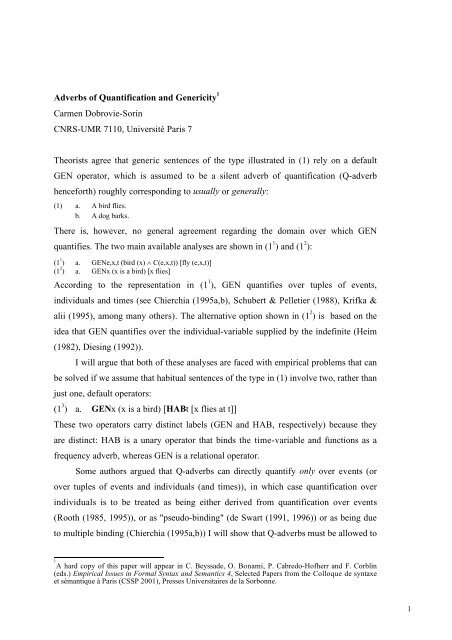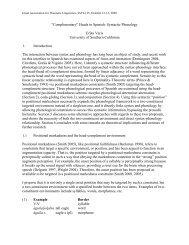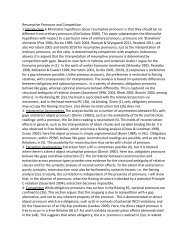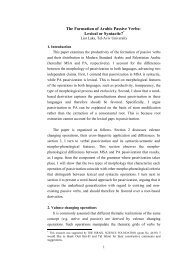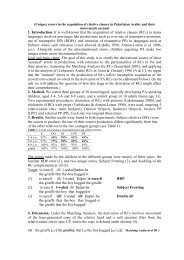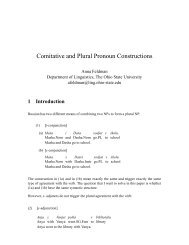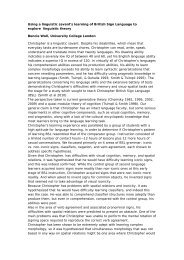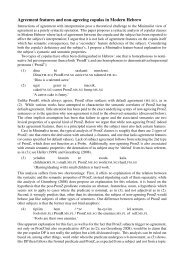Adverbs of Quantification and Genericity Carmen Dobrovie-Sorin ...
Adverbs of Quantification and Genericity Carmen Dobrovie-Sorin ...
Adverbs of Quantification and Genericity Carmen Dobrovie-Sorin ...
You also want an ePaper? Increase the reach of your titles
YUMPU automatically turns print PDFs into web optimized ePapers that Google loves.
<strong>Adverbs</strong> <strong>of</strong> <strong>Quantification</strong> <strong>and</strong> <strong>Genericity</strong> 1<strong>Carmen</strong> <strong>Dobrovie</strong>-<strong>Sorin</strong>CNRS-UMR 7110, Université Paris 7Theorists agree that generic sentences <strong>of</strong> the type illustrated in (1) rely on a defaultGEN operator, which is assumed to be a silent adverb <strong>of</strong> quantification (Q-adverbhenceforth) roughly corresponding to usually or generally:(1) a. A bird flies.b. A dog barks.There is, however, no general agreement regarding the domain over which GENquantifies. The two main available analyses are shown in (1 1 ) <strong>and</strong> (1 2 ):(1 1 ) a. GENe,x,t (bird (x) š C(e,x,t)) [fly (e,x,t)](1 2 ) a. GENx (x is a bird) [x flies]According to the representation in (1 1 ), GEN quantifies over tuples <strong>of</strong> events,individuals <strong>and</strong> times (see Chierchia (1995a,b), Schubert & Pelletier (1988), Krifka &alii (1995), among many others). The alternative option shown in (1 2 ) is based on theidea that GEN quantifies over the individual-variable supplied by the indefinite (Heim(1982), Diesing (1992)).I will argue that both <strong>of</strong> these analyses are faced with empirical problems that canbe solved if we assume that habitual sentences <strong>of</strong> the type in (1) involve two, rather thanjust one, default operators:(1 3 ) a. GENx (x is a bird) [HABt [x flies at t]]These two operators carry distinct labels (GEN <strong>and</strong> HAB, respectively) because theyare distinct: HAB is a unary operator that binds the time-variable <strong>and</strong> functions as afrequency adverb, whereas GEN is a relational operator.Some authors argued that Q-adverbs can directly quantify only over events (orover tuples <strong>of</strong> events <strong>and</strong> individuals (<strong>and</strong> times)), in which case quantification overindividuals is to be treated as being either derived from quantification over events(Rooth (1985, 1995)), or as "pseudo-binding" (de Swart (1991, 1996)) or as being dueto multiple binding (Chierchia (1995a,b)) I will show that Q-adverbs must be allowed to1A hard copy <strong>of</strong> this paper will appear in C. Beyssade, O. Bonami, P. Cabredo-H<strong>of</strong>herr <strong>and</strong> F. Corblin(eds.) Empirical Issues in Formal Syntax <strong>and</strong> Semantics 4, Selected Papers from the Colloque de syntaxeet sémantique à Paris (CSSP 2001), Presses Universitaires de la Sorbonne.1
directly quantify over individuals not only in those generic sentences that expressgeneralizations over individuals (see (1) or the even clearer examples built with i-levelpredicates, e.g., A cat is intelligent), but even in when/if clauses, which constitute theparadigmatic example <strong>of</strong> quantification over events.1 Habitual characterizing sentences: quantification over events or overindividuals?1.1 Event-based accountsAccording to Chierchia (1995a,b), Rooth (1985, 1995), Schubert & Pelletier (1987,1988), de Swart (1991), Krifka & alii (1995), Krifka (1995)), habitual sentences <strong>of</strong> thetype given in (1) are to be analyzed as relying on quantification over triples <strong>of</strong> events,individuals, <strong>and</strong> times:(1) a. A bird fliesb. A dog barks.(1 1 ) a. GENe,x,t (bird (x) š C(e,x,t)) [fly (e,x,t)]b. GENe,x,t (dog (x) š C(e,x,t)) [bark (e,x,t)]The corresponding interpretations can be paraphrased as follows: "Take any bird <strong>and</strong>any situation [event] 2in any world maximally similar to ours where the felicityconditions for flying (such as, e.g., presence <strong>of</strong> the right triggers) are satisfied [...]. Anybird will fly in such a situation [event]." (Chierchia (1995b: 196)).Most authors would leave aside the time-variable because it is sometimes arguedthat this variable coincides with the event-variable. Since I believe that the twovariables are distinct (see Section 3 below), <strong>and</strong> since the time-variable is crucial for theanalysis <strong>of</strong> adverbs <strong>of</strong> quantification, I have inserted it in the representations above. AnLF (Logical Form) in which a time-variable <strong>and</strong> an event-variable are bound by thesame Q-adverb is to be interpreted as corresponding to quantification over episodicevents, i.e., over events that are individuated relative to time-indices. In case no timevariableis projected (see i-level predicates), the Q-adverb will quantify over stable2Although event-based <strong>and</strong> situation-based accounts are technically different, in many particular casesthey coincide in empirical coverage. In this paper, I will use an event-based notation wherever possible,even when reviewing previous proposals (such as Chierchia (1995b)) which, although stated in terms <strong>of</strong>situations, are not set against the formal background <strong>of</strong> situation-semantics (Barwise & Perry (1983)).2
events (or more precisely, over events that are in a one-to-one correspondence withindividuals). The multiple binding <strong>of</strong> event- <strong>and</strong> individual-variables notates the factthat individuals covary with events. This co-variation was analyzed in quite differentways by the various available theories <strong>of</strong> Q-adverbs: the multiple indexing shown in(1 1 ) may thus be intended as (a) an explicit notation <strong>of</strong> unselective binding (in the sense<strong>of</strong> Lewis (1975)) or as (b) iterative/multiple binding (see Chierchia (1995a)) or as (c)selective quantification over events (Rooth (1985, 1995), Schubert & Pelletier (1987,1988), de Swart (1991), etc) combined with the indirect binding (see de Swart's (1991,1996) pseudo-binding) <strong>of</strong> individual-variables. For my present purposes it is notnecessary to distinguish between these various analyses (for further discussion, seeSection 3 below). For concreteness, we may assume that the LF's in (1 1 ) correspond toChierchia's multiple-binding analysis.The LF's in (1 1 ) are problematic ins<strong>of</strong>ar as they cannot explain why the followingexamples cannot be assigned generic readings:(2) a. * A dog is tired.b. * A cow is infected.c. * A fireman is available.Examples <strong>of</strong> this kind could, in principle, be analyzed on a par with those in (1), asexpressing generalizations over episodic events:(2 1 ) a. GENe,x,t (dog (x) š C(e,x,t)) [tired (e,x,t)]The representations in (1 1 ) <strong>and</strong> (2 1 ) are built on the same model, <strong>and</strong> as such should beequally legitimate or illegitimate. The grammaticality contrast between the two classes<strong>of</strong> examples is puzzling.A further problem is raised by examples <strong>of</strong> the type shown below, which exhibit theambiguity glossed in (3)a-b:(3) A student rarely reads novels.a. 'few students read novels'b. 'in general, a student infrequently reads novels'In the (a)-reading, rarely (translated as few) quantifies over individuals, whereas in the(b)-reading the same Q-adverb has the meaning <strong>of</strong> a frequency adverb, roughlycorresponding to infrequently.This ambiguity cannot be accounted for by assuming the type <strong>of</strong> LFrepresentation postulated by the analysis under discussion here:3
(3) FEWe,x,t (student (x) š C(e,x,t)) [read novels (e,x,t)]The interpreation read <strong>of</strong>f this representation would be: few events adequate for novelreading-by-studentsare events <strong>of</strong> novel-reading-by-students. This interpretationcorresponds to none <strong>of</strong> the two intuitive readings <strong>of</strong> (3) described above, both <strong>of</strong> whichexpress generalizations over individuals rather than generalizations over episodicevents.1.2 <strong>Quantification</strong> over individualsAccording to an alternative account that is currently available, the examples in (1) are tobe represented as relying on generic quantification over individuals:(1 2 ) a. GENx (x is a bird) [x flies]The intuitive motivation for this analysis is the fact that (1)a-b express generalizationsover individuals (birds <strong>and</strong> dogs), rather than over events or situations. LF's <strong>of</strong> the typeshown in (1 2 ) can be obtained by assuming Diesing's (1992) Mapping Hypothesis,according to which material in (Spec, IP) is mapped onto the restriction <strong>of</strong> GEN.This proposal is itself confronted with the problems mentioned above. There is,moreover, another obvious difficulty: s-level predicates necessarily project a timevariable(Kratzer (1988, 1995)), which is not represented in (1 2 ). Now, if we introducethe time-variable <strong>and</strong> let GEN bind both variables, we are back at LF's corresponding toquantification over events. If we choose to let GEN bind only the individual-variable,we end up with an illegitimate representation, since the t-variable is left unbound: 3(1 2 ) # GENx (x is a bird) [x flies at t]1.3 The proposal: quantification over individuals <strong>and</strong> over timesMy analysis will rely on the hypothesis that two default Q-adverbs, rather than just one,are at work, which bind respectively the individual-variable supplied by the indefinite<strong>and</strong> the time-variable <strong>of</strong> fly:(1 3 ) GENx (x is a bird) [HABt [x flies at t]]3Representations <strong>of</strong> the type in (1 2 ) would also be illegitimate within the unselective binding hypothesis:although Q-adverbs are allowed to bind indefinitely many variables, the same variables should occur inthe matrix <strong>and</strong> scope.4
These two default Q-adverbs carry distinct labels (HAB <strong>and</strong> GEN, respectively)because they are distinct: they quantify over distinct domains (individuals <strong>and</strong> times,respectively). The representation in (1 3 ) also indicates that GEN, which quantifies overindividuals is relational/binary, whereas HAB, which quantifies over times, functions asa frequency adverb: it is a unary operator ("weak" in the sense <strong>of</strong> Milsark (1977)) thatapplies to an episodic predicate, binds its time-variable, <strong>and</strong> returns the correspondinghabitual predicate. The existence <strong>of</strong> a silent frequency adverb that is distinct from therelational GEN operator is supported by the systematic ambiguity <strong>of</strong> overtly realized Q-adverbs: leaving aside some exceptions (e.g., generally, which seems to be necessarilyrelational), Q-adverbs can function either as frequency adverbs or as relationalquantifiers (see Section 1.4 below).Let me now show that the proposal I just made can solve the problems raisedabove against the two currently available analyses. In order to account for theungrammaticality <strong>of</strong> (2)a-c, we must explain why examples <strong>of</strong> this type cannot beassigned the kind <strong>of</strong> LF shown in (1 3 ). In purely descriptive terms, the problem seemsclear: the main predicates in (2) cannot be interpreted as habitual (tired, infected oravailable cannot be interpreted as meaning 'be regularly tired/infected/available'). Thisimpossibility can be captured by postulating that verbs, but not adjectives, 4 can licensethe insertion <strong>of</strong> a default HAB operator. Now, since HAB cannot be supplied, the timevariablewill remain unbound, which is illegitimate:(2) a. * GENx (dog (x)) [x is tired at t]If we provide an overt Q-adverb, the examples in (2) become acceptable:(4) a. A dog is rarely tired.b. A cow is rarely infected.c. A fireman is rarely available.Since the overt Q-adverb can bind the time-variable <strong>of</strong> tired/infected/available, LF's <strong>of</strong>the type in (4)a are well-formed:(4) a. GENx (dog (x)) few/infrequently i[x is tired at t i]Turning finally to the ambiguity shown in (3), it can be accounted for by assuming theLF's in (3)a-b, each <strong>of</strong> which rely on a default Q-adverb (HAB <strong>and</strong> GEN, respectively)that co-occurs with the overt Q-adverb (rarely, which translates as FEW, may functioneither as a relational operator or as a frequency adverb). The observed ambiguity isanalyzed as a scope-ambiguity:4It may turn out that certain adjectives can take a habitual reading, <strong>and</strong> conversely, certain s-levelpredicates cannot. Further investigation is needed here.5
(3)a. FEWx (x is a student) [HABt [x reads novels at t]]b. GENx (x is a student) [FEWt [x reads novels at t]]1.4. The two generic operators <strong>and</strong> the ambiguity <strong>of</strong> Q-adverbsIn sum, we were lead to postulate the existence <strong>of</strong> two selective default operators, whichare introduced via distinct mapping principles:(5) a. HAB, which binds a time-variable, is a weak quantifier/unary operator that modifies the predicate.b. GEN is a binary/relational operator that quantifies over individuals.This proposal reconciles Carlson's (1977) early view that the generic operator is unarywith later analyses, including Carlson (1989), relying on a binary operator. Under myview, these hypotheses are not exclusive <strong>of</strong> each other, but they are both necessary: asin Carlson's (1977) analysis, the operator that is responsible for the habitual use <strong>of</strong> s-level predicates is unary. But unlike Carlson (1977), <strong>and</strong> more in line with lateraccounts, I assume the existence <strong>of</strong> a distinct binary quantifier, which is responsible forthe generic reading <strong>of</strong> indefinites.The existence <strong>of</strong> two distinct generic operators, a unary <strong>and</strong> a relational one, isstrongly supported by the systematic ambiguity <strong>of</strong> Q-adverbs. As observed by de Swart(1991), most <strong>of</strong> the overtly realized Q-adverbs, see in particular rarely, sometimes,usually, etc. may function either as relational/binary operators or as frequency adverbs,in which case they are to be analyzed as weak/unary operators. Note, however, thataccording to de Swart, frequency adverbs are irrelevant for the issue <strong>of</strong> genericity: ingeneric sentences, Q-adverbs are necessarily to be analyzed as relational operators thatquantify over events.According to the analysis proposed here, a frequency adverb may co-occur with arelational Q-adverb. This view is supported by examples <strong>of</strong> the type in (6), whichcontain two overt Q-adverbs:(6) Generally a student rarely reads novels.GENx (x is a student) [FEWt (x reads novels at t)]The co-occurrence <strong>of</strong> two relational Q-adverbs or two frequency adverbs is ruled out bygeneral principles: only one type <strong>of</strong> constituent is allowed inside the same syntacticdomain (functional uniqueness). Other constraints probably exist, which are out <strong>of</strong> thescope <strong>of</strong> this paper.6
Note, however, that two Q-adverbs need not co-occur: relational <strong>and</strong> unary Q-adverbs may occur on their own. We thus expect three possibilities: (i) a relational Q-adverb occurring on its own; (ii) a unary Q-adverb occurring on its own; (iii) arelational Q-adverb co-occurring with a unary Q-adverb. The choice between thesethree logical possibilities depends on various factors, such as the lexical properties <strong>of</strong>the main verb, the type <strong>of</strong> DP that constitutes the Topic <strong>of</strong> the generalization, syntacticproperties <strong>and</strong> information structure. Some <strong>of</strong> these possibilities will be illustrated inSection 3.5. below.2 Event-based Representations for Generic Characterizing SentencesI have so far made an empirical claim: habitual sentences <strong>of</strong> the type in (1) rely on LF'sthat contain two, rather than just one Q-adverb. Correspondingly, they expressgeneralizations over individuals (to which a habitual property is attributed), rather thangeneralizations over episodic events. The next issue is theoretical: how do we representgeneralizations over individuals?2.1 Adverbial <strong>Quantification</strong> over IndividualsCharacterizing sentences built with i-level predicates constitute the simplest possibleexample <strong>of</strong> generic sentences expressing generalizations over individuals:(7) A dog is usually intelligent.(7) GENx (x is a dog) [x is intelligent]Representations such as that in (7) are in line with the theory <strong>of</strong> Q-adverbs developedby Lewis (1975), Kamp (1981), Heim (1982), according to which (overt or covert)adverbs <strong>of</strong> quantification, are unselective: they bind all free variables in their domain. Inthose contexts in which the only available variables are individual-variables, Q-adverbsquantify over individuals.2.2 Deriving <strong>Quantification</strong> over Individuals from <strong>Quantification</strong> over EventsEvent-based approaches propose a more constrained theory, according to which Q-7
adverbs directly/selectively quantify only over events or situations (Rooth (1985, 1995),Schubert & Pelletier (1987, 1988), de Swart (1991)). (Generic) quantification overindividuals would be derived from (generic) quantification over events (Rooth (1985,1995) <strong>and</strong> de Swart (1991, 1996)). A somewhat weaker theory is proposed by Chierchia(1995a,b) <strong>and</strong> Krifka & alii (1995), Krifka (1995), etc, who assume multiple binding:in addition to binding an event-variable, the Q-adverb may bind one or more individualvariables.Rooth (1995) tries to demonstrate that the LF in (7)c, corresponding toquantification over individuals, is to be derived from the more basic LF given in (7)a,in which the Q-adverb quantifies over events. In (7)a-c I have preserved, with slightmodifications, Rooth's notation. Although Rooth's LF's do not contain event-variables,they notate quantifications over events, because the restriction contains a propositionalconstituent:(7) a. usually (a dog (x) š x has some property) [a dog(x) š x is intelligent]b. usually (a dog (x)) [a dog(x) š x is intelligent]c. usually (a dog (x)) [x is intelligent]According to Rooth, the LF in (7)a is obtained by assuming that: (i) the whole sentencegoes to the matrix <strong>of</strong> usually; (ii) the restriction is filled with the focus closure <strong>of</strong> thematrix: since in this case the focused constituent is the VP, the focus closure is anexistentially closed variable over properties, which in informal English can beparaphrased as "has some property". Since "having some property" is a trivial conditionon the variable, it can be suppressed, which allows Rooth to derive (7)b. Finally, (7)breduces to (7)c due to the semantics <strong>of</strong> one variant <strong>of</strong> the DRT model.De Swart (1996) follows Rooth in assuming that Q-adverbs basically quantifyover events, but according to her, quantification over individuals is not represented atLF, but only constitutes a pragmatic inference for those examples in which there is aone-to-one mapping between events <strong>and</strong> individuals.Going back to the habitual characterizing sentences examined in Section 1above, it should be clear that the analysis proposed there can be restated within anevent-based framework: the habitual predicate habitually read novels (relying on adefault HAB operator) would constitute the matrix, <strong>and</strong> a corresponding "trivial"property would go to the restriction:8
Rooth's argument in favor <strong>of</strong> subsuming characterizing sentences under his associationwith-Focustheory is that Rhematic Focus constitutes a particular type <strong>of</strong> Focusedconstituent. One can however argue against identifying the two types <strong>of</strong> Focus:contrastive Focus introduces a set <strong>of</strong> event-alternatives, whereas Rhematic Focusintroduces new information without presupposing alternatives to it.Rooth (1995) himself acknowledges that no compelling evidence exists in favor<strong>of</strong> applying the association-with-focus theory to examples such as the one in (7). Wemay instead assume the Mapping Rule in (9). For my present purposes, it is notnecessary to choose between the two versions <strong>of</strong> (9) given in (i)-(ii): the examplesunder examination are built with preverbal subjects, which go to the restriction on either(9)i or (9)ii (The difference between the two rules becomes relevant for those sentencesin which the Topic is an element other than the preverbal subject).(9) (i) Material in (Spec, IP) goes to restriction <strong>of</strong> Q-adverbs (Diesing (1992))(ii) Topic DPs go to the restriction <strong>of</strong> Q-adverbs (Partee (1995)).By applying either one <strong>of</strong> these rules, we derive LF representations in which the Q-adverb quantifies over individuals, not over events.2.4 Asymmetric readings <strong>of</strong> if/when-clausesFollowing Lewis (1975), it is currently assumed that if/when-clauses are mapped ontothe restriction <strong>of</strong> the Q-adverb, <strong>and</strong> the main clause goes to the matrix. Since sententialconstituents may be analyzed as denoting sets <strong>of</strong> events, the Q-adverb may be assumedto quantify over events. This analysis can be stated within generalized quantifiers theory(de Swart (1991, 1996)): the Q-adverb denotes the relation between the sets <strong>of</strong> events(notated as lambda-abstracts over events in (10)c <strong>and</strong> (11)c) denoted by the if-clause<strong>and</strong> the main clause, respectively. In order to avoid taking an explicit st<strong>and</strong> regardingthe way in which the individual variables corresponding to event-participants are bound,I have slightly modified de Swart's (1996) representations: instead <strong>of</strong> assuming adynamic existential quantifier that binds individual-variables, I assume that eventparticipantsare introduced as the values <strong>of</strong> functions from events to individuals. The10
elevant functions correspond to the various th-roles, 5 the exact labels <strong>of</strong> which areirrelevant here:(10) a. If a woman has a cat, she usually likes it.b. USUALLY (a woman ihas a cat j) [she ilikes it j]c. USUALLY (e have (e) š woman (Th-role1 (e)) š cat (Th-role2 (e))) [e like (e)](11) a. If a drummer lives in an apartment building, it is usually empty.b. USUALLY (a drummer lives in an apartment building i) [it iis empty]c. USUALLY (e live in (e) š drummer (Th-role1 (e)) š ap. build. (Loc (e))) [e empty (e)]The LF in (10)c tells us that USUALLY denotes the relation between the set <strong>of</strong> events <strong>of</strong>possession in which the Possessor is a woman <strong>and</strong> the Possessed is a cat <strong>and</strong> the set <strong>of</strong>events <strong>of</strong> liking (that have the same participants). This LF, just like the one in (11)c,corresponds to a symmetric reading: (10)c says that most events in which a possessionrelation holds between a woman <strong>and</strong> a cat are events in which a liking relation holds;similarly, the LF in (11)c says that most <strong>of</strong> the events in which a drummer lives in anapartment building are events in which the apartment building is empty. These LF's areproblematic, since they do not correspond to the intuitive readings, which areasymmetric: the Q-adverb quantifies over women who own cats <strong>and</strong> over apartmentbuildings in which drummers live, respectively. In order to account for asymmetricreadings, we must assume that only some <strong>of</strong> the indefinites occurring in the restriction<strong>of</strong> a Q-adverb get bound by it (see a woman <strong>and</strong> an apartment building in (10) <strong>and</strong> (11),respectively). Most theorists suggest that in order for an indefinite to get bound by theQ-adverb, it must be a Topic (see Chierchia (1995a,b) <strong>and</strong> de Swart (1996)). But we arethen lead to conclude that Q-adverbs do not quantify exclusively over events, but ratherover pairs <strong>of</strong> events <strong>and</strong> individuals. The LF's in (10)d <strong>and</strong> (11)d can be obtained byassuming the Coindexing algorithm <strong>and</strong> the Mapping rules proposed by Chierchia(1995a), who allows Q-adverbs to bind several variables (multiple binding):(10) d. USUALLY e,x(have (e,x) š woman (x) š cat (Th-role2 (e))) [like (e)](11) d. USUALLY e,y(live in (e, y) š drummer (Th-role (e)) š ap. building (y)) [be empty (e)]De Swart (1996) attempts to avoid multiple binding <strong>and</strong> to maintain the more5This type <strong>of</strong> notation is currently used in some <strong>of</strong> the neo-Davidsonian approaches:(i) xye (write (e) š Agent (e,x) š Theme (e, y) š Loc (e, t))(ii) xye (be intelligent (e) š Theme (e, x)).In (i)-(ii), the main predicate is analyzed as a property that restricts an event-variable; the arguments <strong>and</strong>the modifiers <strong>of</strong> the predicate are introduced as functions from events onto objects. The values <strong>of</strong> thesefunctions can be identified with particular individuals: Agent (e,x) is to be read as "the Agent <strong>of</strong> e is x".But they can also be left unspecified: thus, in (10) <strong>and</strong> (11), the indefinites do not supply individuals, butmerely a property that restricts the range <strong>of</strong> the value <strong>of</strong> the function: woman (Th-role1 (e)) is to be readas "the first argument <strong>of</strong> the event (<strong>of</strong> possession) is a woman".11
constrained view that Q-adverbs can quantify only over events. She treats indefinites asdynamic existential quantifiers, but she is nevertheless forced to assume that theindefinites that constitute the Topic <strong>of</strong> the generalization ("in the sense that thegeneralization expressed by the sentence is 'about' that NP" (de Swart (1996:182)), aresubject to a particular treatment: they are formally speaking existential quantifiers, butthey get "pseudo-bound" by the Q-adverb. But we must then assume some (secondary)indexing that notates pseudo-binding. Once this mechanism is explicitated (which deSwart did not do), it will probably turn out to be quite similar to Chierchia's multiplebinding, which in fact undermines the hypothesis that Q-adverbs quantify only overevents.We are thus lead to conclude that any analysis <strong>of</strong> Q-adverbs must resort toquantification over individuals. The next question to be examined is whetherquantification over events is at all necessary.3 Adverbial quantification without event-variablesIn what follows I will reject the hypothesis that event-variables are necessarilyprojected in the argument-structure <strong>of</strong> sentential predicates. I will then show that withinsuch a framework, Q-adverbs can be analyzed as quantifying over (i) individuals (ortuples <strong>of</strong> individuals), (ii) times or (iii) tuples <strong>of</strong> times <strong>and</strong> individuals.3.1 Event-variables are not part <strong>of</strong> the argument-structure <strong>of</strong> predicatesThe view that event-variables are not part <strong>of</strong> the argument-structure <strong>of</strong> predicates issupported by an obvious syntactic observation: no syntactic position can be identified ascorresponding to the event-variable. Note furthermore that there is a peculiar restrictionon event-variables: with run-<strong>of</strong>-the-mill predicates, the e-variable must be assumed tobe necessarily bound by existential closure:(15) Mary was angry yesterday.(15) e angry (e, Mary, yesterday)Compare predicates that subcategorize for sentential complements:(16) It annoyed/disturbed me that he came home so late.12
In examples <strong>of</strong> this type, the main predicate must be assumed to have two eventvariables,an "external" one (bound by existential closure) <strong>and</strong> an "internal" one, whichis saturated by the embedded clause:(16)e 2e 1(annoyed/disturbed (e 1, x, e 2) š x = I) (that he came home so late)Given the peculiar behavior <strong>of</strong> external e-variables, we may want to assume a morecanonical argument-structure, which contains individuals, time-, space-localizers, aswell as "internal", but no "external" event-variables. Sentences are composed in thest<strong>and</strong>ard way, by saturating the argument-slots <strong>of</strong> the predicate.Under this view, however, we seem to lose the explanations proposed byDavidson (1967) <strong>and</strong> Parsons (1990) for the entailments triggered by modifiers. Ibelieve that it is possible to meet both ends by assuming type-shifting rules <strong>of</strong> the kindin (17), which apply only if P is a sentential predicate:(17) a. x P(x) Ÿ e,x P(e,x)b. x P(x) Ÿ x e P(e,x)These type-shifting rules allow us to reconcile the syntactic level <strong>of</strong> representation (atwhich no external event-variable is introduced) with the necessity <strong>of</strong> accounting forDavidsonian entailments.3.2 If/when-clauses: adverbial quantification over individualsI will now attempt to show that it is possible to account for adverbial quantificationwithout using e-variables. In other words, the type-shifting rules introduced above arenot needed for the analysis <strong>of</strong> Q-adverbs, although they may well be useful for otherphenomena. I will start with if/when-clauses, which constitute the paradigmatic example<strong>of</strong> quantification over events, <strong>and</strong> I will argue that even in this case, the Q-adverb canbe analyzed as quantifying over individuals.As already discussed in Section 2.4 above, the asymmetric readings <strong>of</strong> if/whenclauses can be accounted for only if we assume that Q-adverbs bind, in addition to theevent-variable, only one <strong>of</strong> the individual-variables occurring in the restriction. Here, Iwill argue that binding the event-variable is not needed: binding one <strong>of</strong> the individualvariablesis sufficient. But which variable? According to both Chierchia (1995a,b) <strong>and</strong>de Swart (1996), Q-adverbs bind (or merely "pseudo-bind", as argued by de Swart13
(1996)) the variable supplied by the Topic, but it is left implicit whether it is the Topic<strong>of</strong> the restriction or the Topic <strong>of</strong> the matrix that is relevant. Since it is the restriction thatsupplies the domain <strong>of</strong> quantification, one might be tempted to believe that it is theTopic <strong>of</strong> the restriction that gets bound by the Q-adverb. It seems however clear thatwhat matters is the Topic <strong>of</strong> the matrix. The most obvious argument in favor <strong>of</strong> thisassumption is the fact that the Q-adverb has widest scope, hence it takes scope over thematrix, <strong>and</strong> presumably binds the highest argument in that domain:(18) A Q-adverb binds the variable supplied by the Topic <strong>of</strong> the Matrix.Now, if the restrictor contains variables that are coindexed with the variable supplied bythe Topic <strong>of</strong> the matrix, the Q-adverb will end up binding those variables also. Byapplying this procedure to our examples, we obtain the tripartite configurations shownin (10)e <strong>and</strong> (11)e, in which usually translates as MOST. The analysis <strong>of</strong> the dependantindefinite <strong>and</strong> <strong>of</strong> the corresponding donkey-pronoun is out <strong>of</strong> the scope <strong>of</strong> this paper.For concreteness, I will assume that the dependent indefinite is to be represented as anexistentially closed function-variable (see Comorovski (1999)) that applies to theindividual variable that is bound by the quantifier <strong>and</strong> yields an individual that rangesover the set denoted by the nominal predicate contained in the dependent indefinite (forthe examples under discussion here, the values <strong>of</strong> the relevant functions range over cats<strong>and</strong> drummers, respectively):(10) e. MOST xf (x has f(x) š woman (x) š cat (f(x))) [x likes f(x)](11) e. MOST xf (f(x) lives in x š apartment building (x) š a drummer f(x)) [x is empty] 6According to these LF's, the Q-adverbs quantify over arguments <strong>of</strong> sententialpredicates, which corresponds to quantifying over event-participants: "most <strong>of</strong> theindividuals who have a cat (<strong>and</strong> are women) are such that they like that cat"; "most <strong>of</strong>the places (that are apartment buildings) in which a drummer lives are such that they areempty".In sum, I have adopted a framework which dispenses with event-variables. Sets <strong>of</strong>event-participants can be obtained by abstracting over one <strong>of</strong> the argument-positions <strong>of</strong>6These tripartite configurations can be translated in terms <strong>of</strong> generalized quantifier theory: the Q-adverbis analyzed as denoting the relation between two sets <strong>of</strong> entities, which are obtained by abstracting overthe variables that are bound by the quantifier:(10) f. MOST f (x (x has f(x) š woman (x) š cat (f(x))) [x (x likes f(x)](11) f. MOST f (x (f(x) lives in x š apart. building (x) š a drummer f(x))) [x (x is empty)]14
a sentential predicate. "Adverbial quantification over events" is an improper label for arelation that is to be represented as quantification over event-participants. Moreprecisely, the relevant type <strong>of</strong> LF is one in which the Q-adverb binds an individualvariable,<strong>and</strong> the restriction contains a sentential predicate. Representing quantificationover events as quantification over event-participants (arguments <strong>of</strong> sententialpredicates) seems adequate not only because the asymmetric readings <strong>of</strong> if/whenclausescan be accounted for, but also on more general grounds: it is indeed well-knownthat events can be individuated only if they are relativized to individuals (or to times).In other words, strictly speaking, it is not possible to count or to quantify over events:we can only count <strong>and</strong> quantify over event-participants (or times at which an eventtakes place).3.3 If/when-clauses: adverbial quantification over timesLet us now consider if/when-clauses that contain s-level predicates:(19) When it rains, I stay home.Following Kratzer (1988, 1995), I will assume that s-level predicates necessarily projecta time-variable, 7 which cannot remain free. If it is not assigned a particular index, atime-variable gets bound by the closest Q-adverb:(20) If a free time-variable occurs in the scope <strong>of</strong> a Q-adverb, it gets bound by it.We thus derive the LF in (19):(19) GEN t(it rains at t) [I stay home at t]According to this representation, the Q-adverb quantifies over times: (19) is interpretedas saying that most <strong>of</strong> the times at which it rains are such that I stay home at thosetimes. This corresponds to quantifying over events that are individuated relative totimes.Other examples are somewhat more complex:(21) If a bishop meets a sinner, he rarely blesses him.7As discussed in the Appendix below, the arguments raised against Kratzer's (1988) proposal do not reallyaffect the core <strong>of</strong> her generalization.15
(21) FEW x,tf (x meets f(x) at t š bishop (x) š sinner (f(x))) [x blesses f(x) at t]Representations <strong>of</strong> this type, in which the Q-adverb binds a pair <strong>of</strong> an individual- <strong>and</strong> atime-variable, are to be interpreted as quantifications over stages <strong>of</strong> individuals, or moreprecisely over arguments <strong>of</strong> s-level predicates: (21) is interpreted as saying that few <strong>of</strong>the individuals (that are bishops) who meet a sinner at t are such that they bless him at t.3.4 Characterizing sentences: adverbial quantification over individualsLet us consider next characterizing generic sentences, i.e., monoclausal genericsentences that have a Topic-Comment configuration:(22) A cat is usually intelligent.Just like in generic if/when-clauses, the Q-adverb will bind the variable supplied by theTopic. There is, however, a crucial difference between if/when-clauses <strong>and</strong> genericsentences <strong>of</strong> the type in (22): in the latter case there is no pre-existant bipartition into aRestrictor <strong>and</strong> a Matrix. More precisely, the overall sentence belongs to the Matrix, butthere is no syntactically-defined Restrictor. We therefore need a further Mapping Rule.The reader may choose between (9)i or (9)ii, repeated here as (23)i-ii:(23) i. Material in (Spec, IP) goes to restriction <strong>of</strong> Q-adverbs (Diesing (1992))ii. Topic DPs go to the restriction <strong>of</strong> Q-adverbs (Partee (1995)).We can thus obtain the LF in (22):(22)USUALLY x(cat(x)) [x is intelligent]Nominal predicates denote event-independent sets <strong>of</strong> individuals such as students, cats,etc. This type <strong>of</strong> domain <strong>of</strong> quantification crucially differs from the one thatcharacterizes if/when-clauses: in the latter case, the Q-adverb quantifies over arguments<strong>of</strong> sentential predicates, which are interpreted as event-participants. Thus, althoughformally speaking, the Q-adverb quantifies over individuals in both types <strong>of</strong> genericsentences, the domains <strong>of</strong> quantification are radically different, due to the differenttypes <strong>of</strong> restrictions (nominal vs sentential predicates). Correlatively, I propose todistinguish between two types <strong>of</strong> generic indefinites:(24) a. An indefinite takes a "truly" generic reading if it is selectively bound by a Q-adverb. (therestriction is filled with a nominal predicate). See (22).b. An indefinite takes a pseudo-generic reading if it is indirectly bound by a Q-adverb that binds theargument-variable <strong>of</strong> a sentential predicate. See (10), (11), <strong>and</strong> (21).16
3.5 Habitual sentencesIn the previous section we have examined monoclausal generic sentences built with i-level predicates. Such sentences are <strong>of</strong> necessity characterizing, in the sense that theynecessarily rely on quantification over individuals, <strong>and</strong> correspondingly are interpretedas expressing generalizations about (event-independent) individuals.Monoclausal generic sentences built with s-level predicates are more complex,because <strong>of</strong> the presence <strong>of</strong> the time-variable projected by such predicates. Suchsentences may be assigned distinct representations, depending on whether they rely onthe occurrence <strong>of</strong> two Q-adverbs or on just one <strong>of</strong> them.The first possibility is to let the time-variable <strong>and</strong> the individual-variable bebound by distinct operators. This option, which has already been exploited in Section 1above, underlies habitual characterizing sentences (e.g., A bird flies, A dog barks), i.e.,generic sentences that attribute a habitual property (derived by applying a unary Q-adverb, in particular HAB, to an s-level predicate) to individuals (generalizing overindividuals relies on a binary Q-adverb).It is however not necessary to supply two Q-adverbs: a relational quantifier isneeded only in those configurations that rely on some kind <strong>of</strong> bipartition, in particularthe one induced by a Topic-Comment split. Consider instead thetic sentences(sometimes referred to as all-Focus configurations):(25) a. A cow is rarely infected on this farm.b. A fireman is rarely available in this town.In such sentences, rarely can be analyzed as a frequency adverb binding the timevariable;the individual-variable supplied by the indefinite subject can be assumed to bebound by existential closure:(25)FEWt x [x is a cow š x is infected at t on this farm]These LF's are interpreted as asserting the infrequent occurrence <strong>of</strong> events <strong>of</strong> cowinfectionor fireman-availability.There is yet a third possibility <strong>of</strong> analyzing monoclausal habitual sentences: onlya relational Q-adverb is at work, which binds both the time- <strong>and</strong> the individualvariables.Note now that quantifying over pairs <strong>of</strong> individuals <strong>and</strong> times is equivalent to17
quantifying over time-indexed individuals (stages <strong>of</strong> individuals). It is, however,plausible to assume that a relational quantifier cannot quantify over stages <strong>of</strong>individuals because <strong>of</strong> the structure <strong>of</strong> this domain: just like the domain <strong>of</strong> times, thedomain <strong>of</strong> stages <strong>of</strong> individuals is ordered by the part-whole relation, which means thatthe elements <strong>of</strong> this domain are not individuated, <strong>and</strong> as such cannot be counted. Wemay further conjecture that adverbial quantification over stages <strong>of</strong> individuals ispossible only if the restriction contains an event-predicate. The Q-adverb thus ends upquantifying over event-participants rather than over event-independent individuals.Some nominal modifiers, e.g., gerunds, may provide the necessary event-predicate:(26) An elephant walking in the middle <strong>of</strong> the street has always caused curiosity.(26) GENx,t (x is an elephant <strong>and</strong> x is walking .. at t) [x has caused curiosity at t]In other monoclausal configurations, there is no overt event-predicate that could go tothe restriction. It is however possible for the restriction to be filled with a sententialconstituent that can be inferred from the overt sentence. One possibility is Rooth's(1985, 1995) association-with-focus theory, which applies in those sentences thatcontain a contrastively focused constituent (see examples (8)a-b above). Anothermapping rule was proposed by Schubert&Pelletier (1987, 1988), who assume that therestriction is filled with the presupposition <strong>of</strong> the matrix:(27) a. A cat l<strong>and</strong>s on its feet.b. Three chatter-boxes won't travel long together.c. A u usually follows a q.(27) a. ALLx,t (x is a cat <strong>and</strong> x falls to the ground at t) [x l<strong>and</strong>s on its feet at t]We have thus reached the conclusion that certain monoclausal generic sentences areindeed comparable to if/when-clauses, ins<strong>of</strong>ar as they rely on an LF characterized by arestriction that contains a sentential predicate. Correspondingly, such sentences areinterpreted as quantifying over event-participants. This is, however, only one <strong>of</strong> thethree possible representations <strong>of</strong> generic monoclausal sentences.ConclusionsThe main purpose <strong>of</strong> the presentation above was to establish the basic types <strong>of</strong> LFrepresentations for sentences containing Q-adverbs. We saw that Q-adverbs can beeither analyzed as relational/binary operators or as frequency adverbs, in which casethey function as unary operators that bind the time-variable <strong>of</strong> s-level predicates.Frequency adverbs may occur on their own, as in habitual existential sentences, or they18
may co-occur with relational Q-adverbs, as in habitual characterizing sentences.Relational Q-adverbs may quantify either over event-independent individuals (as incharacterizing sentences) or over event-participants. The latter possibility underliesif/when-clauses, as well as those monoclausal generic sentences in which the restriction<strong>of</strong> a relational Q-adverb is filled by a sentential predicate (as a result <strong>of</strong> Mapping Rulesthat take into account contrastive Focus or presuppositions).Appendix: event-variables <strong>and</strong> time-variablesAccording to Kratzer (1988, 1995), the difference between i(ndividual)-level/stable <strong>and</strong>s(tage)-level properties (see intelligent <strong>and</strong> invite, respectively) can be characterized interms <strong>of</strong> the lack vs the presence <strong>of</strong> an argument for spatiotemporal location (alocalization-variable). Despite Kratzer's own (1988, 1995: 126) view, the localizationvariablecharacteristic <strong>of</strong> s-level predicates should not be identified with theDavidsonian event-variable, which can be postulated for any kind <strong>of</strong> predicate,including i-level predicates (see Chierchia (1995)). We may instead assume that therelevant difference between s-level <strong>and</strong> i-level predicates is the presence <strong>of</strong> a timevariable.The necessary distinction between event-variables <strong>and</strong> time-variables isobvious as soon as we consider their syntactic status: locations clearly constitutesyntactic constituents, which occupy syntactic positions. No such position can bepostulated for event-variables, which as such have no syntactic status.Let us then consider the hypothesis that only s-level predicates project timevariables.This characterization itself was further refined by de Swart (1991), whoobserved that i-level predicates do have time-variables (e.g., when he was a child, Johnwas blond), which are however peculiar ins<strong>of</strong>ar as they can receive only one value(relative to the same individual). In other words, the real difference between i-level <strong>and</strong>s-level predicates is that the former carry a uniqueness presupposition: an i-levelpredicate can apply only once to the same individual, whereas s-level predicates applyrecurrently to the same individual. This characterization allows de Swart to explain whyi-level predicates behave on a par with once-only predicates that are clearly s-level (die,build the house <strong>of</strong> Mary, write Liaisons Dangereuses). This uniqueness presupposition19
(in more simple terms, the fact that the time-variable cannot be assigned more than onevalue relative to the same individual), which characterizes i-level <strong>and</strong> once-onlypredicates alike, explains why the time-variables <strong>of</strong> such predicates cannot be bound bya Q-adverb: quantification can only apply to a domain that contains at least two entities(the plurality constraint on quantification). S-level predicates satisfy the pluralityconstraint regardless <strong>of</strong> whether the DPs occurring in the restriction introduce variablesor constants: in Mary rarely reads novels when she is tired, the Q-adverb counts thenumber <strong>of</strong> times at which Mary reads novels. The relevant domain contains more thanone time-index, simply because read novels may recurrently apply to Mary. The timevariable<strong>of</strong> i-level predicates, on the other h<strong>and</strong>, cannot satisfy the plurality constrainton quantification, which means that it cannot be bound by a Q-adverb. In other words,an example such as *Mary is rarely tall is ruled out by the plurality constraint onquantification rather than by the lack <strong>of</strong> a time-variable: for predicates such as tall, thereis only one time-value for each assignment to an individual, <strong>and</strong> hence the time-variablecannot provide a domain for the Q-adverb to quantify over.In sum, de Swart's revision <strong>of</strong> Kratzer's definition says that once-only predicates(including i-level predicates) cannot supply a time-variable for the Q-adverb to bind.This revision does not affect Kratzer's claim that whenever the main predicate is i-level,the Q-adverb is forced to quantify over individuals (recall that I have demonstratedabove that we need not assume that Q-adverbs quantify over events).ReferencesCarlson, G. N. 1977a. Reference to kinds in English. Univ. <strong>of</strong> Massachusetts. Diss.Carlson, G. N. 1977b. A unified analysis <strong>of</strong> the English bare plural. Linguistics <strong>and</strong>Philosophy 1. 413-457.Carlson, G.N. & F.J. Pelletier. eds 1995. The generic book. Chicago. The Univ. <strong>of</strong>Chicago Press.Carlson, G. N. 1989. The Semantic Composition <strong>of</strong> English Generic Sentences. In G.Chierchia, B. Partee <strong>and</strong> R. Turner (eds.) Properties, Types, <strong>and</strong> Meaning, vol. 2:Semantic Issues, Dordrecht: Kluwer, 167-191.Chierchia, G. 1995a. Dynamics <strong>of</strong> Meaning. Chicago University Press.20
Chierchia, G. 1995b. Individual-level predicates as inherent generics. G. N. Carlson &F. J. Pelletier (eds), 176-223.G.N. Carlson & F. J. Pelletier (eds) 1995. The generic book. Chicago. The Univ. <strong>of</strong>Chicago Press.Comorovski, I. 1999. Functional indefinites <strong>and</strong> the proportion problem. In F. Corblin,C. <strong>Dobrovie</strong>-<strong>Sorin</strong> & J.M. Mar<strong>and</strong>in (eds.) Empirical Issues in Formal Syntax <strong>and</strong>Semantics 2, Selected Papers from the Colloque de syntaxe et sémantique à Paris(CSSP 1997), Thesus, The Hague, 17-37.Davidson, D. 1967. The Logical Form <strong>of</strong> action sentences. In N. Rescher (ed.), TheLogic <strong>of</strong> Decision <strong>and</strong> Action, University <strong>of</strong> Pittsburgh Press, 81-95.De Swart, H. 1991. <strong>Adverbs</strong> <strong>of</strong> <strong>Quantification</strong>: A Generalized Quantifiers Approach.Ph.D. dissertation, Rijksuniversiteit Gröningen.De Swart, H. 1996. (In)definites <strong>and</strong> genericity. In M. Kanazawa, C.J. Piñon & H. deSwart (eds) Quantifiers, Deduction <strong>and</strong> Context, CSLI, Stanford, 171-1994.Diesing, M. 1992. Indefinites, Cambridge, Mass.: MIT Press.<strong>Dobrovie</strong>-<strong>Sorin</strong>, C. (2002), Generic Plural Indefinites, In F. Corblin & H. de Swart(eds.), CSLI, Stanford.<strong>Dobrovie</strong>-<strong>Sorin</strong>,, C. & B. Laca 1998. La génericité entre la référence à l'espèce et laquantification générique. In P. Sauzet (ed), Langues et grammaire 3, Syntaxe :Communications présentées au colloque Langues et grammaire III (juin 1997),Université de Paris 8, 163-177.Heim, I. 1982. The semantics <strong>of</strong> definite <strong>and</strong> indefinite noun phrases. Univ. <strong>of</strong>Massachusetts. Diss.Kamp, H. 1981. A Theory <strong>of</strong> Truth <strong>and</strong> Semantic Representation. Formal Methods inthe Study <strong>of</strong> Language, eds. J.A.G. Groenendijk, T.M.V. Janssen & M.B.J.Stokh<strong>of</strong>, Mathematical Centre Tract 135, Amsterdam, pp. 277-322.Kratzer, A. 1988. Stage-level <strong>and</strong> individual-level predicates. M. Krifka (ed.), 247-284.Kratzer, A. 1995. Stage-level <strong>and</strong> individual-level predicates. In G.N. Carlson & F. J.Pelletier (eds), 125-175.Krifka, M. ed. 1988. <strong>Genericity</strong> in Natural Language. Proceedings <strong>of</strong> the 1988Tübingen Conference. Tübingen. SNS-Bericht 88-42.Krifka, M. & alii. 1995. <strong>Genericity</strong>: an introduction. In G.N. Carlson & F.J. Pelletier21
(eds) 1995. 1-124.Lewis, D.K. 1975. <strong>Adverbs</strong> <strong>of</strong> <strong>Quantification</strong>, In E. Keenan (ed.) Formal Semantics <strong>of</strong>Natural Language, Cambridge University Press, 3-15.Milsark, G. 1977, Toward an Explanation <strong>of</strong> Certain Peculiarities in the ExistentialConstruction in English, Linguistic Analysis 3, 1-30.Parsons, T. 1990. Events in the Semantics <strong>of</strong> English. Cambridge, Mass: MIT Press.Partee, B. 1995, <strong>Quantification</strong>al Structures <strong>and</strong> Compositionality, <strong>Quantification</strong> inNatural Languages, eds. E. Bach, E. Jelinek, A. Kratzer, B.H. Partee, Kluwer,541-603.Rooth, M. 1985, Association with Focus. Ph.D. dissertation, Massachusetts.Rooth, M. 1995, Indefinites, adverbs <strong>of</strong> quantification, <strong>and</strong> Focus Semantics, in G. N.Carlson /F.J. Pelletier eds., 265-299.Schubert, L. K. <strong>and</strong> Pelletier, F. J. 1987. Problems in the Representation <strong>of</strong> the LogicalForm <strong>of</strong> Generics, Plurals, <strong>and</strong> Mass Nouns. New Directions in Semantics, ed. E.LePore, London:Academic Press, 385-451.Schubert, L. K. <strong>and</strong> Pelletier, F. J. 1988. An Outlook on Generic Statements. In M.Krifka, ed. 357-372.22


